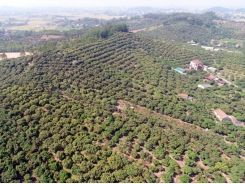Rice exports drop in first months of this year

Export of rice of Vietnam has been facing several disadvantages as countries which previously imported rice from Vietnam now have produced rice themselves and even participated in exporting rice.
Export of rice in the first months of this year is extremely gloomy. (Photo: SGGP)
Figures by the General Department of Vietnam Customs show that in the first five months of this year, rice exports reached 2.76 million tons, down 6.3 percent over the same period last year, worth US$1.18 billion, down 20.4 percent. The Philippines became the main export market of Vietnamese rice, accounting for 38.6 percent of total rice exports.
According to the Ministry of Industry and Trade, except the Philippines, other major rice importing markets, including China, Indonesia and Bangladesh, reduced import of rice in the first half of this year possibly because of high inventory of previous crop in China, election year in Indonesia and production resumption after flooding in Bangladesh.
Six-month forecast by the US Department of Agriculture showed that global rice supply is expected to rise due to increasing rice production, of which, Thailand’s rice production surges 138,000 tons compared to the previous year; India’s soars 2.87 million tons; and Cambodia’s edges up 79,000 tons.
Not only Vietnam but also India and Thailand experienced a slump in export of rice. In the first five months of last year, rice exports of Vietnam to China, Indonesia and Bangladesh hit 1.44 million tons but in the first five months of this year, rice exports to these three markets dropped drastically to 239,000 tons. Rice exports of Thailand to these three markets also fell by 71.6 percent over the same period last year.
Mr. Tran Quoc Khanh, deputy minister of the Ministry of Industry and Trade, said that in recent years, rice importing countries have made changes in policy for rice, such as imposing tax on many rice products, changing rice importing method, allowing more suppliers to participate in government-to-private auctions so as to have a rice supply with more competitive price and higher quality. Rice importing countries also have struggled to improve domestic rice production capacity, aiming for food sovereignty. Meanwhile, rice producing countries have taken advantages of natural conditions to focus on growing high-quality and well-known rice varieties.
Countries like Myanmar, Cambodia and Pakistan all put great efforts in increasing the amount of rice for exporting. China has also become one of the largest rice exporters in the world.
These movements have made global rice supply and inventory at rice exporting countries increase and change significantly the supply-demand relationship in the way that the market belongs to buyers.
According to the Ministry of Industry and Trade, amid this context, the management of export of rice should ensure the balance between export and domestic consumption, stabilize domestic rice prices, especially amid the context the prices of various essential consumer goods climbed.
During the first months of this year, it is recorded a shift in market mechanism and rice export structure as well as efforts to find and expand new and potential export market of Vietnamese rice traders. Although facing difficulties in Asia and Oceania, Vietnamese firms have promoted export of fragrant rice to Africa, Europe and America.
Related news
Tools

Phối trộn thức ăn chăn nuôi

Pha dung dịch thủy canh

Định mức cho tôm ăn

Phối trộn phân bón NPK

Xác định tỷ lệ tôm sống

Chuyển đổi đơn vị phân bón

Xác định công suất sục khí

Chuyển đổi đơn vị tôm

Tính diện tích nhà kính

Tính thể tích ao




 FTAs generate opportunities, challenges to Vietnam’s agriculture
FTAs generate opportunities, challenges to Vietnam’s agriculture  New Zealand supporting development of fruit industry
New Zealand supporting development of fruit industry